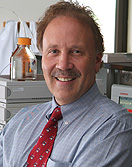News
Designation gives UB role in improving patient safety, reducing medical errors
-
 Print
Print -
 Comments
(1)
Comments
(1)
-

“It’s all designed to give providers the tools they need to improve patient outcomes with better access to these kinds of medical management data.”
The Medication Management Research Network (MMRN) at UB’s New York State Center of Excellence in Bioinformatics and Life Sciences has a new role in helping to improve patient safety in Western New York as a result of its recent designation by the federal government as a Patient Safety Organization (PSO).
The MMRN at UB received the designation from the U.S. Department of Health and Human Services’ Agency for Healthcare Research and Quality; it’s the first academic institution in New York State to receive the designation and only the second Patient Safety Organization named in the state.
The announcement comes about a year after the MMRN was established by the UB Center of Excellence and the School of Pharmacy and Pharmaceutical Sciences with the goal of establishing a statewide infrastructure for conducting research in medication management.
“As a Patient Safety Organization, MMRN now has the ability not just to conduct valuable research on how specific health care decisions impact patient outcomes and health care costs, but it enables us to report back to health care providers on patterns we discover through data analysis,” explains Gene D. Morse, principal investigator on the MMRN, professor in the School of Pharmacy and Pharmaceutical Sciences and associate director of the UB Center of Excellence. “It allows us to identify issues quickly, develop improved early-warning systems that communicate ways to reduce risk and improve quality, and to set up mechanisms through which we will report back to the clinical sites so that they can then take steps to efficiently avoid potentially dangerous and costly medication errors.”
For example, he says, it now will be possible for the PSO to closely track potential drug interactions among prescriptions for individual patients and then report back to the clinical site about those interactions so that the provider can make the necessary changes.
These capabilities, Morse explains, have been made possible by the digitization of medical records, prescriptions and other health information.
Currently, the UB PSO is working with health care providers in Western New York to collect, store and analyze “de-identified” information from patients with HIV/AIDS, kidney disease and diabetes. The effort also involves collaboration with UB’s computer scientists, who are developing ways to digitize handwritten medical records and merge data sources through data fusion.
The MMRN currently has funding from Health Research Inc. of the New York State Department of Health through its Pharmaceutical Safety Initiative.
PSOs are the result of The Patient Safety and Quality Improvement Act, which Congress passed in 2005 to improve the collection of data on, and response to, adverse events in the health care system.
According to Morse, the MMRN at the Center of Excellence is well suited for designation as a Patient Safety Organization because of its mission to use information technology to link scientific and medical literature to the clinical level, which has long been a focus of the School of Pharmacy and Pharmaceutical Sciences.
In addition, he notes, the existence of the Center for Computational Research (CCR) at the Center of Excellence was critical.
“It is necessary that there are systems in place that allow for the Patient Safety Organization to collect and analyze these vast amounts of patient data and then to feed the results of the analysis back to the clinical sites,” Morse says. “We are privileged that in CCR we have the robust computational resources, including hardware, software and human expertise, in place that we need to comply with the requirements of the legislation.”
Morse expects that pilot projects currently under way will transition to more formalized collaborations by this summer and that by the fall participating clinical providers will be able to easily access information about their patients through a secure Web site.
“We envision that providers will be able to log in at their convenience and see how their site is doing and ask questions,” he says. “It’s all designed to give providers the tools they need to improve patient outcomes with better access to these kinds of medical management data.”
The MMRN is one component of the Health and Wellness Across the Lifespan UB 2020 strategic strength; it includes faculty from each of the health sciences in the Academic Health Center.
In addition to Morse, other UB faculty working on the MMRN and the PSO include Russell W. Bessette, associate vice president for health sciences and director of health information technology; Tom Furlani, CCR director; Venu Govindaraju, professor of computer science and engineering, School of Engineering and Applied Sciences; Rocco C. Venuto, Brian Murray, both professors of medicine, and Paresh Dandona, UB Distinguished Professor of Medicine, all in the School of Medicine and Biomedical Sciences; Deborah S. Finnell, assistant professor, School of Nursing; and Cara M. Felton, clinical instructor, Karl D. Fiebelkorn, associate dean, and Linda Catanzaro, Fred Doloresco and Jack Brown, all clinical assistant professors in the Department of Pharmacy Practice, School of Pharmacy and Pharmaceutical Sciences.

Reader Comments
Gurdev Singh says:
I am delighted to read the news that MMRN has listed itself as a PSO with Agency for Health Research and Quality [http://www.pso.ahrq.gov/listing/listprocess.htm]. Congratulations. We at UB Patient safety Research Center are delighted to welcome this PSO to the fold of Patient Safety and are looking forward to working with it. A visit to our web site should give the readers some idea of our work since 2001[www.fammed.buffalo.edu/safety and www.patientsafety.buffalo.edu w.e.f March 14th].
Posted by Gurdev Singh, Director, Pateint Safety Research Center , 04/08/10